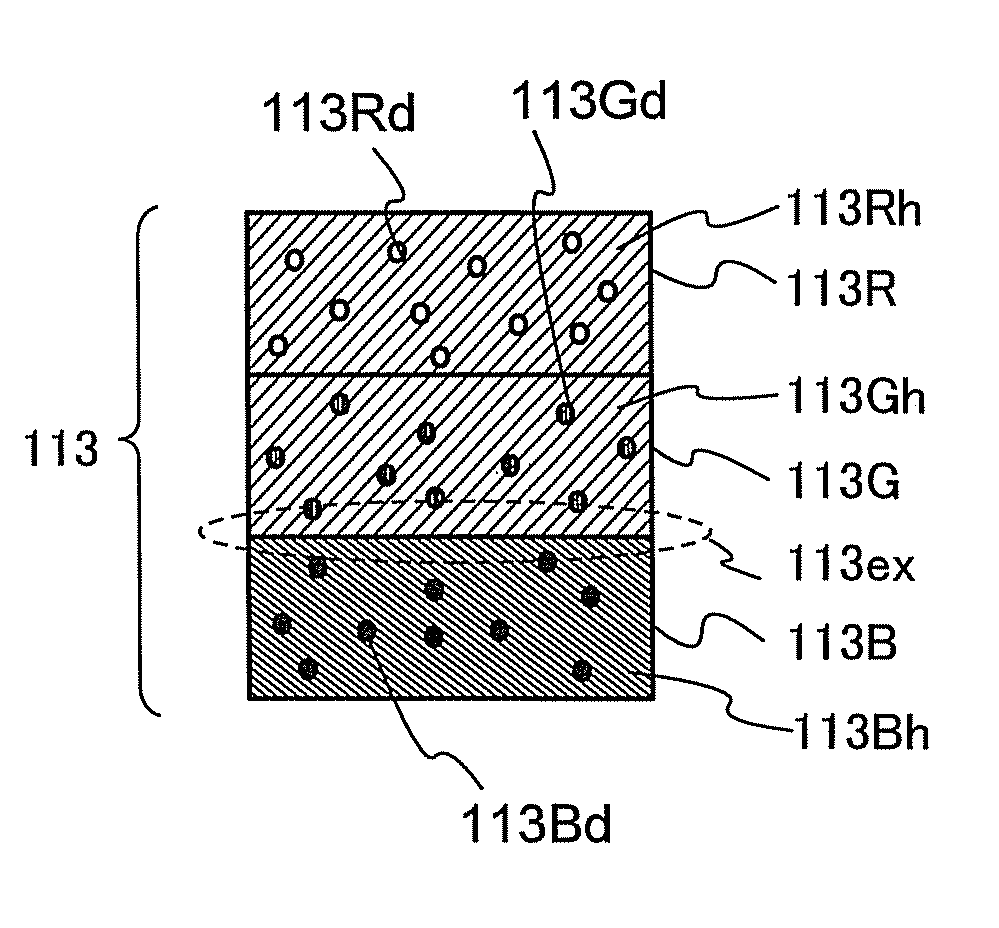Light-emitting element, light-emitting device, display device, electronic device, and lighting device
a technology of light-emitting devices and light-emitting elements, which is applied in the direction of semiconductor devices for light sources, light-emitting heating devices, fixed installations, etc., can solve the problems of difficult to obtain highly efficient light emission, difficult to keep a balance between, and difficult to achieve high efficiency. , to achieve the effect of reducing power consumption and high emission efficiency
- Summary
- Abstract
- Description
- Claims
- Application Information
AI Technical Summary
Benefits of technology
Problems solved by technology
Method used
Image
Examples
embodiment 1
[0068]An operation principle of a light-emitting element of one embodiment of the present invention will be described. The point of the present invention is that a first phosphorescent compound emitting blue light (specifically, a phosphorescent compound having an emission peak at 440 nm to 520 nm, or a phosphorescent compound emitting light of a color in a color gamut in which a CIE chromaticity (x, y) is 0.12≦x≦0.25 and 0.05≦y≦0.5) and second and third phosphorescent compounds emitting light (e.g., green light or red light) with wavelengths longer than the wavelength of the blue light emitted from the first phosphorescent compound are used and all of the first to third phosphorescent compounds are made to emit light efficiently, whereby a multicolor light-emitting element with high efficiency is obtained.
[0069]As a general method for obtaining a multicolor light-emitting element including a phosphorescent compound, a method can be given in which a plurality of kinds of phosphoresc...
embodiment 2
[0110]In this embodiment, a detailed example of the structure of the light-emitting element described in Embodiment 1 will be described below with reference to FIGS. 1A to 1C.
[0111]A light-emitting element in this embodiment includes, between a pair of electrodes, an EL layer including a plurality of layers. In this embodiment, the light-emitting element includes the first electrode 101, the second electrode 102, and the EL layer 103, which is provided between the first electrode 101 and the second electrode 102. Note that in this embodiment, description is made on the assumption that the first electrode 101 functions as an anode and that the second electrode 102 functions as a cathode. In other words, when a voltage is applied between the first electrode 101 and the second electrode 102 so that the potential of the first electrode 101 is higher than that of the second electrode 102, light emission can be obtained.
[0112]Since the first electrode 101 functions as the anode, the first...
embodiment 3
[0149]In this embodiment, a light-emitting device using the light-emitting element described in Embodiments 1 and 2 will be described.
[0150]In this embodiment, the light-emitting device using the light-emitting element described in Embodiments 1 and 2 is described with reference to FIGS. 6A and 6B. Note that FIG. 6A is a top view of the light-emitting device and FIG. 6B is a cross-sectional view taken along the lines A-B and C-D in FIG. 6A. This light-emitting device includes a driver circuit portion (source line driver circuit) 601, a pixel portion 602, and a driver circuit portion (gate line driver circuit) 603, which are to control light emission of the light-emitting element and illustrated with dotted lines. Moreover, a reference numeral 604 denotes a sealing substrate; 625, a drying agent; 605, a sealing material; and 607, a space surrounded by the sealing material 605.
[0151]Reference numeral 608 denotes a wiring for transmitting signals to be inputted into the source line dri...
PUM
 Login to View More
Login to View More Abstract
Description
Claims
Application Information
 Login to View More
Login to View More - R&D
- Intellectual Property
- Life Sciences
- Materials
- Tech Scout
- Unparalleled Data Quality
- Higher Quality Content
- 60% Fewer Hallucinations
Browse by: Latest US Patents, China's latest patents, Technical Efficacy Thesaurus, Application Domain, Technology Topic, Popular Technical Reports.
© 2025 PatSnap. All rights reserved.Legal|Privacy policy|Modern Slavery Act Transparency Statement|Sitemap|About US| Contact US: help@patsnap.com



